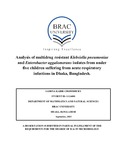| dc.contributor.advisor | | |
| dc.contributor.advisor | Mannoor, Dr. Md. Kaiissar | |
| dc.contributor.advisor | Hossain, Dr. Mahboob | |
| dc.contributor.author | Chowdhury, Samina Kabir | |
| dc.date.accessioned | 2015-10-29T05:29:16Z | |
| dc.date.available | 2015-10-29T05:29:16Z | |
| dc.date.copyright | 2015 | |
| dc.date.issued | 2015-09 | |
| dc.identifier.other | ID 11126001 | |
| dc.identifier.uri | http://hdl.handle.net/10361/4526 | |
| dc.description | This thesis report is submitted in partial fulfillment of the requirement for the degree of B.Sc in Microbiology, 2015. | en_US |
| dc.description | Cataloged from PDF version of thesis report. | |
| dc.description.abstract | Emergence of resistance against multiple types or classes of antibiotics among bacterial pathogens associated with Acute Respiratory Infection (ARI) is a global concern. Since, ARI still remains the major cause of child death worldwide, this loss of effectiveness of antibiotics can cause severe health problems of children suffering from acute respiratory infections. Acute respiratory infection (ARI) is the leading cause of mortality and morbidity among <5 children in developing countries like Bangladesh. In this study we focused on elucidating the correlation between antibiotic resistance and plasmids in two multi-drug resistant bacterial respiratory isolates obtained from an ARI surveillance study conducted in Dhaka. From 196 nasal swab specimens collected for a systematic ARI surveillance study from under-five patients presented to Dhaka Medical College Hospital (DMCH) and Shaheed Suhrawardy Medical College Hospital (SSMCH), Two isolates of multidrug resistant (MDR) bacteria-one Klebsiella pneumoniae and Enterobacter aggalomerans were found. The isolates were identified and confirmed by microbiological culture and appropriate biochemical tests, and their multi-drug resistance characteristics were confirmed by disc diffusion method. Plasmid curing was performed on the two MDR isolates using Ethidium bromide, SDS, and elevated temperature curing methods, and antibiotic sensitivity testing was performed to check its effect on their multi-drug resistance. Both isolates were found resistant towards ampicillin, azithromycin, levofloxacin, amoxicillin, tobramycin, cefixime, cefotaxime, penicillin, gentamycin, imipenem, trimethoprim and gentamycin. The minimum inhibitory concentration (MICs) of Ethidium bromide was determined. Loss of plasmid by Ethidium bromide treatment correlated with loss of resistance to antibiotics in cured strains. Plasmid curing with SDS produced similar results. Curing plasmid DNA by elevated temperature (45°C) produced significant changes in Enterobacter aggalomerans cells but had little effect on K. pneumoniae. The results of this study can help direct the mechanistic investigation of multi-drug resistance in respiratory pathogens explore newer avenues. | en_US |
| dc.description.statementofresponsibility | BRAC University thesis are protected by copyright. They may be viewed from this source for any purpose, but reproduction or distribution in any format is prohibited without written permission. | |
| dc.description.statementofresponsibility | Cataloged from PDF version of thesis report. | |
| dc.language.iso | en | en_US |
| dc.publisher | BRAC University | en_US |
| dc.rights | BRAC University thesis are protected by copyright. They may be viewed from this source for any purpose, but reproduction or distribution in any format is prohibited without written permission. | |
| dc.subject | Klebsiella pneumoniae | en_US |
| dc.subject | Enterobacter aggalomerans | en_US |
| dc.subject | Acute respiratory | en_US |
| dc.title | Analysis of multidrug resistant Klebsiella pneumoniae and Enterobacter aggalomerans isolates from under five children suffering from acute respiratory infections in Dhaka, Bangladesh. | en_US |
| dc.type | Thesis | en_US |
| dc.contributor.department | Department of Mathematical and Natural Science, BRAC University | |
| dc.contributor.department | | |
| dc.description.degree | B. Microbiology | |

